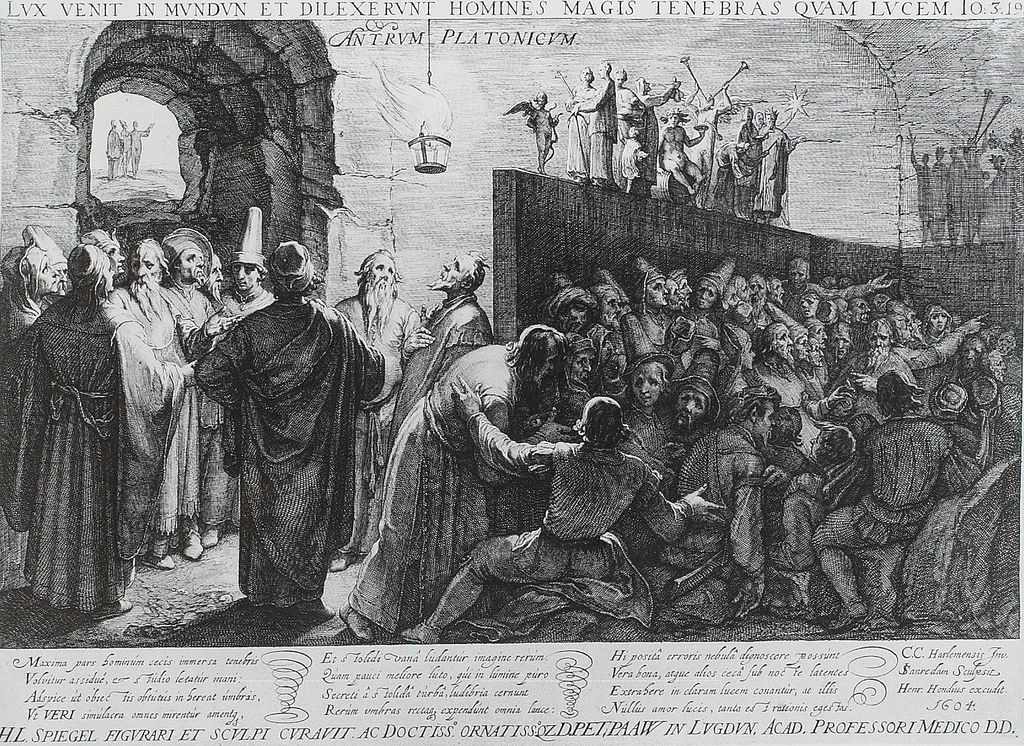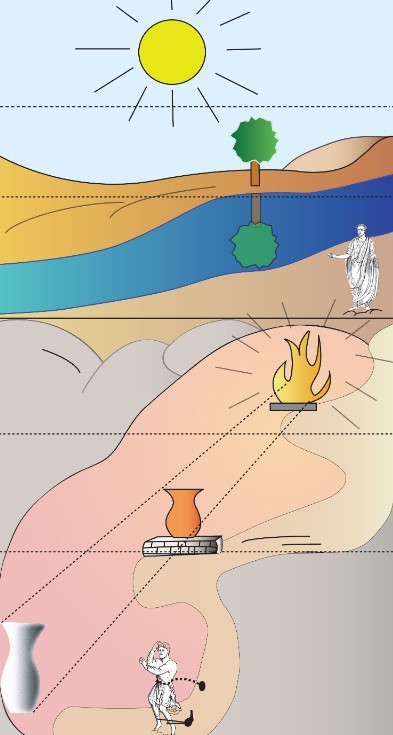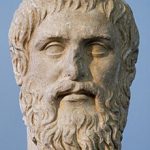Lesson THEME: allegory of the cave (plato)
The Allegory (parable) of the Cave, or Plato’s Cave, was presented by the Greek philosopher Plato in his work Republic to compare “the effect of education and the lack of it on our nature”. It is written as a dialogue between Plato’s brother Glaucon and his mentor Socrates.
Activity 1:
Listening exercise
Listen to the following 30-second sound clip:
Activity 2:
PICTURE


Describe what you see, in as much detail as possible.
Activity 3:
ARTICLE
Plato’s Parable of the Cave
Philosophers have always tried to bring out the truth about human nature as well as providing details of the psychological evolution of humanity. In their works, they expound on the essence of various aspects of human behavior. Most philosophers employ symbolism to create the general image of the aspect/behavior in question. A renowned Greek philosopher, Plato, did one such works-The Parable of the Cave. The parable explains the cause as well as the effect of limited knowledge to a society.
The parable is in the form of a conversation between Socrates and Glaucon, Plato’s brother. The conversation begins with Socrates asking Glaucon to imagine an underground cave inhabited by humans. The people, who have spent their life from childhood in the cave, have their necks and legs chained thus unable to move. There is a fire blazing in a distance above and behind the prisoners with a raised wall erected between the prisoners and the fire over which some marionette players show their puppets.
The prisoners are only able to see the shadow of the puppets on the wall of the cave-their only way of being acquainted to the outside world. All the prisoners do is to name the objects they see their shadows on the wall. One’s ability to judge the object remains as the only way to measure an individual’s intellect. Consequently, the prisoners’ world revolves around the confines of the cave.
As the parable unfolds, one of the prisoners manages to get out of the cave. Since he was only familiar with the little light in the cave, the bright light of the outside world stands as a great challenge. However, he conquers all the challenges he faced in the outside world and manages to interact with the various elements of nature in the ‘real world’. Eventually he gathers the truth and he decides to share it with the prisoners in the cave. However, the prisoners greatly oppose the new truth about the world.
The parable obtains its meaning from the symbols that Plato employed. Among the symbols that Plato used are the puppets. A puppeteer manipulates a puppet in a way that it imitates events and activities that occur under different circumstances. The shadows of the puppets that appear on the wall of the cave are similarly imitations of the puppets thus of events that occur in reality. The shadows constitute the main source of ideas, from which the prisoners obtain their intellect. They greatly influence the thinking capabilities of the prisoners.
Therefore, their definition of the world depends entirely on their experiences as well as observations within the confines of the cave. Owing to this, we can say that the puppets represent or rather signify the various norms and beliefs that different societies hold.
Most people live as prisoners of these belief systems without questioning the integrity as well as the intentions of the people who came up with them. The puppeteer represents the members of a society who knowingly manipulate the beliefs of others. Just like the prisoners in the cave, many people may never get to see the ‘puppeteers’ whose works make them to unknowingly live with limited knowledge of the truth.
The puppets may also signify the limited truth that people get from their environments. It is clear from the parable that the puppets were the main cause of the shadows on the wall. Additionally, the prisoners had their hands and necks tied rendering them helpless.
They could not move or even turn to have a view of the rest of the world except that within the cave. Their imprisonment shows that someone or a group of people did not want them to have access to any other source of information and knowledge other than the one they got from the puppets.
For Socrates to tailor such a scenario, he must have had in mind that the people who had taken the prisoners into captivity were entirely responsible for the propagation of the shadows on the wall, which was the sole source of information to the prisoners. They did not want them to access much information thus designed the kind of information that their prisoners would access which acted as the major source of their knowledge. The freed prisoner comes to understand the limitations of the information that prisoners in the cave rely on.
He gets exposure to the truth and learns that they were living in falsehood since all they had ever known and believed in were imitations of the real world. We can liken the people who had taken the prisoners into captivity to people especially some political leaders as well as religious leaders who deliberately try to convince their subjects/the public of what they know is charade. For some reason, such leaders use all means within their disposition to manipulate the minds of their followers to earn their loyalty.
Another significant symbol that Plato employed in the parable is fire. The fire is the source of the light that leads to the propagation of the shadows on the wall. The fire signifies the natural power of the human mind-the source of man’s inner knowledge, which is universal.
According to Socrates, several factors govern one’s ability to perceive things in the natural mindset. For instance, his/her distance from the truth. This explains why Plato brings out the distinction between the lives of the prisoners in the dark cave and those off their counterparts in the outside world. For one to gain the full potential of his/her mind, he/she has to shun all forms of mediocrity-the chains that bind the prisoners’ legs and necks.
It was only after one of the prisoners gained his freedom and got to see the fire that he was able to see the objects that had cast the shadows on the wall of the cave-the reality. The difference of the intensity of the light as depicted in the parable depends on an individual’s distance from the fire/source of light. As the prisoner gets out of the cave the brightness of the light increases and he is able to get a different perception of the world.
Though he faced many challenges, he chose to believe in the reality of the world outside the cave thus was accustomed to the ‘real truth’. This closely relates to Father Augustine’s ideological content of his Catholic theology and faith. He urged people to seek not to understand that they may believe but should believe to understand.
When Socrates says that, “they seem less real than shadows” he means that what the prisoners had as their source of knowledge was far from the truth. The basis of their knowledge was unimaginable in a normal setting. When the freed prisoner comes to the outside world, the fire frightens him just because it is so intense.
This signifies the fear that people have in facing the reality. The prisoner was only familiar with a dark world, a world with limited knowledge. When he faces the source of the truth which he least expected, he gets afraid of the things he should go through to adjust to the new world. The source of the truth in most societies is education. It comes with different challenges, which frightens many people as in the case of the freed prisoner’s initial encounter with fire-the fear of the unknown.
Activity 4:
Debate
Statement: “Most people are blind to the truth and are to scared to face the truth”
Do you agree – why or why not?
Take a stand point and defend your opinion.
Activity 5:
QuOte:
“We can easily forgive a child who is afraid of the dark; the real tragedy of life is when men are afraid of the light.
Plato
Please explain what your understanding is of this quote.
Do you agree or disagree with it? Why or why not?
Activity 6:
role play:
Scenario 1: Explain to a 12 year old child the lessons we can learn from “The allegory of the cave”.
Scenario 2: A new colleague needs help to write a business report. How will you help him?
.
Activity 7:
IDIOMS:
English idioms, proverbs, and expressions are an important part of everyday English. Because idioms don’t always make sense literally, you’ll need to familiarize yourself with the meaning and usage of each idiom.
Learning to use common idioms and expressions will make your English sound more native, so it’s a good idea to master some of them.
All that glitters is not gold
Cross a bridge when one comes to it
Fall into the trap
Get something under one’s belt
Get the short end of the stick
Activity 8:
ASK QUESTIONS REGARDING THESE STATEMENTS:
The exact time and place of Plato’s birth are unknown.
Plato was six years younger than Isocrates,
Plato died at the age of 81 on the same day he was born.
Activity 9:
headlines:
Human rights mean nothing unless we defend real, threatened people.
Did you consent to being born? Why one man is suing his parents for giving birth to him.
If universities sacrifice philosophy on the altar of profit, what’s next?
Activity 10:
Homework:
Write a 300 word parable to demonstrate why business ethics are important.
This is a writing and speaking exercise.
